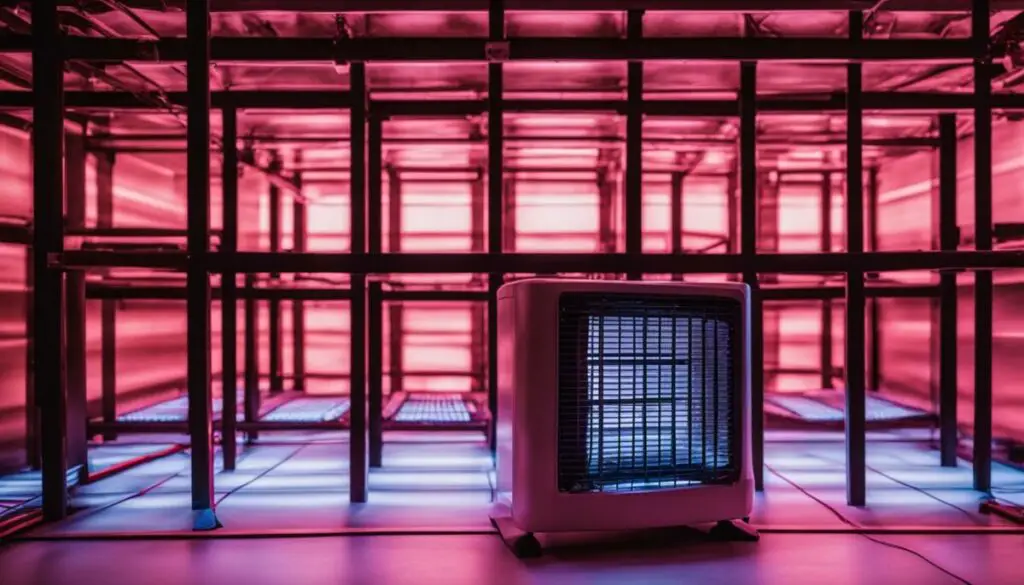Last Updated on 5 months by Francis
Welcome to our comprehensive guide on infrared heaters! If you’re wondering whether infrared heaters are quiet and searching for silent heating options, you’ve come to the right place. Infrared heaters have gained popularity for their ability to provide instant heat and their numerous benefits. But are they really quiet? Let’s dive into the details and uncover the truth about the noise level of infrared heaters.
Contents
Key Takeaways:
- Infrared heaters emit focused heat rays that warm objects directly, similar to the sun.
- They operate silently, as they do not require air circulation like traditional convection heaters.
- Infrared heaters offer instant, even heat distribution without drying out the air or reducing humidity.
- They are cost-effective, energy-efficient, and provide health benefits such as improved blood circulation.
- However, consider the limitations of infrared heaters, such as their focused heating range and potential safety concerns.
How Do Infrared Heaters Work?

Infrared heaters operate by emitting a focused beam of heat that directly warms objects in the surrounding area. Similar to the heat emitted by the sun, these heaters work instantly by emitting heat rays that quickly raise the temperature of the objects they come into contact with. Unlike traditional convection heaters, infrared heaters do not rely on air circulation, making them operate silently. This is because they do not require fans or motors to distribute heat.
Instead of heating the air, infrared heaters emit heat that is absorbed by objects, including walls, floors, and furniture, resulting in even heat distribution throughout the room. This method of heat transfer prevents the air from becoming dry and maintains the humidity levels, making it a comfortable and healthy heating option. The energy efficiency of infrared heaters is also noteworthy, as they only heat specific areas, saving energy compared to other types of heaters that warm up entire rooms.
“Infrared heaters emit a focused beam of heat that warms objects directly, similar to the heat from the sun. They work instantly by emitting heat rays that quickly warm up the surrounding area. Unlike traditional convection heaters, infrared heaters do not require air circulation and therefore operate silently.”
Heat Emission of Infrared Heaters
The heat emission of infrared heaters is achieved through wavelengths of electromagnetic radiation, primarily in the far infrared range. These wavelengths are invisible to the human eye but are capable of penetrating the air and efficiently transferring heat to objects. The process begins with the heating elements of the infrared heater, which can be made of materials such as ceramic, quartz, or metal. These elements are heated up by electricity or gas, causing them to emit infrared radiation that travels in a straight line until it encounters an object. Upon contact, the object absorbs the radiation and is warmed up, increasing the ambient temperature of the room.
The heat emitted by infrared heaters is gentle and comfortable, promoting better blood circulation and providing a cozy environment. The even distribution of heat ensures that no areas are left cold or overheated, creating a balanced and pleasant heating experience. Additionally, the ability of infrared heaters to emit heat without combustion or the use of fans makes them a clean and environmentally friendly heating option.
| Types of Infrared Heaters | Heat Emission Mechanism |
|---|---|
| Electric Infrared Heaters | Electric heating elements |
| Natural Gas Infrared Heaters | Gas combustion |
| Propane Infrared Heaters | Propane combustion |
Benefits of Infrared Heaters
Infrared heaters offer a range of benefits that make them a popular choice for heating homes and workplaces. One of the key advantages of infrared heaters is their quiet operation. Unlike traditional convection heaters, which rely on fans to circulate warm air, infrared heaters emit heat directly onto objects, resulting in a silent heating experience. This makes them ideal for noise-sensitive environments such as bedrooms, offices, or libraries.
Another advantage of infrared heaters is their ability to provide comfortable and even warmth. These heaters do not rely on air circulation to distribute heat, which means they don’t create drafts or reduce humidity levels. This is beneficial for individuals who suffer from allergies or respiratory issues, as it helps maintain a healthy indoor environment.
Infrared heaters are also known for their energy efficiency and cost-effectiveness. They heat specific areas directly, rather than wasting energy on heating the entire room. This targeted heating approach can result in significant energy savings and lower heating costs. Additionally, infrared heaters require minimal maintenance and come in stylish designs that can complement any decor, making them both practical and aesthetically pleasing.
Table: Comparison of Infrared Heaters with Other Types of Heaters
| Feature | Infrared Heaters | Convection Heaters | Oil-Filled Heaters |
|---|---|---|---|
| Noise Level | Quiet | May produce noise due to fan operation | Quiet |
| Heat Distribution | Directly warms objects and people | Convection currents circulate warm air | Convection currents circulate warm air |
| Energy Efficiency | High | Varies depending on efficiency rating | Varies depending on efficiency rating |
| Humidity Level | No reduction in humidity | May reduce humidity levels | No reduction in humidity |
| Heating Cost | Targeted heating reduces overall cost | Varies depending on usage and energy source | Varies depending on usage and energy source |
Overall, infrared heaters provide a range of benefits including quiet operation, even heat distribution, energy efficiency, and low maintenance requirements. These factors make them an attractive heating option for individuals looking for effective and convenient ways to stay warm during the colder months.
Limitations of Infrared Heaters
Infrared heaters offer numerous benefits, but it is important to consider their limitations before making a decision. Understanding these drawbacks will help you determine if an infrared heater is the right choice for your specific heating needs.
Inadequate Widespread Heating
One limitation of infrared heaters is their focused heating mechanism. While they provide efficient and targeted heat to their immediate vicinity, they may struggle to provide widespread warmth in larger rooms or areas beyond their reach. If you need consistent heat throughout a larger space, other types of heaters may be more suitable.
Rapid Temperature Drop
When an infrared heater is turned off, it stops radiating heat, resulting in a rapid decrease in room temperature. This can be a disadvantage if you prefer a constant temperature or need warmth for an extended period. If you require long-lasting heat retention, alternative heating options may be better suited to your needs.
Potential Safety Risks
Older models of infrared heaters can have extremely hot coils, which can pose a risk to children and pets if touched accidentally. However, newer models are equipped with safety features to mitigate this danger. When selecting an infrared heater, it is essential to consider the safety measures in place to protect your loved ones.
| Limitations of Infrared Heaters | Drawbacks | Disadvantages |
|---|---|---|
| Inadequate widespread heating | Rapid temperature drop | Potential safety risks |
| May struggle to provide consistent warmth in larger rooms | Heat dissipates quickly once turned off | Older models with hot coils can pose a danger to children and pets |
| Alternative heaters may be more suitable for consistent whole-room heating | Not ideal for extended periods of warmth | Newer models have safety features to mitigate risks |
Understanding the limitations of infrared heaters will help you make an informed decision. Consider the size of the space you need to heat, your preferences for consistent temperature, and the safety measures required for your household. By evaluating these factors, you can determine if an infrared heater is the right choice for you.
Safety Considerations

When using infrared heaters, it is essential to prioritize safety to ensure a secure and comfortable environment. Modern infrared heaters often come equipped with safety features that mitigate potential risks. However, it is still important to follow specific precautions and guidelines to ensure safe operation and minimize any hazards.
Safety Features of Infrared Heaters
Infrared heaters are designed with several safety features that protect users from potential accidents. These features include:
- Cool-to-the-touch cabinets: Many infrared heaters are constructed with cool-to-the-touch cabinets, reducing the risk of accidental burns. This feature is especially crucial for households with children or pets, providing peace of mind during operation.
- Automatic shut-off: Some infrared heaters are equipped with automatic shut-off mechanisms that activate when the heater reaches a specific temperature or tips over. This ensures that the heater does not pose a fire hazard if left unattended or if it accidentally falls over.
- Overheat protection: Infrared heaters often have built-in overheat protection systems that automatically power off the unit if it exceeds a safe operating temperature. This prevents the risk of overheating and potential fire hazards.
It is important to familiarize yourself with the specific safety features of the infrared heater you choose and ensure they meet your safety requirements.
Precautions for Safe Use
To ensure safe operation and prevent accidents, consider the following precautions when using infrared heaters:
- Read the manufacturer’s instructions: Before using an infrared heater, carefully read and understand the manufacturer’s instructions for installation, usage, and maintenance. Adhering to these guidelines will help you use the heater correctly and safely.
- Keep flammable objects away: Maintain a safe distance between the infrared heater and any flammable materials, such as curtains, furniture, or clothing. This prevents the risk of fire or other hazards.
- Place the heater on a stable surface: Ensure that the infrared heater is placed on a stable surface to prevent accidental tipping or falls. This reduces the risk of injury and damage to the surrounding area.
- Avoid using extension cords: It is advisable to plug the infrared heater directly into a wall outlet rather than using an extension cord. This reduces the risk of electrical hazards and ensures a stable power supply.
- Regularly clean and maintain the heater: Follow the manufacturer’s instructions for cleaning and maintenance to keep the infrared heater in optimal condition. Regular cleaning of reflectors and filters helps maintain efficiency and prevents potential malfunctions.
By following these safety precautions and utilizing the available safety features of infrared heaters, you can enjoy the benefits of efficient and silent heating while ensuring the well-being of yourself and others.
Efficiency and Environmental Impact

When it comes to heating solutions, efficiency and environmental impact are important factors to consider. Infrared heaters excel in both these aspects, making them a sustainable choice. Let’s explore the efficiency of infrared heaters and their minimal environmental impact.
Efficiency: Infrared heaters are known for their energy efficiency. Unlike traditional heaters that heat the entire room, infrared heaters deliver targeted heat to specific areas. This focused heating approach ensures that energy is not wasted on heating unused spaces. The energy transfer ratio of infrared heaters is almost 1:1, meaning that the heat is directly delivered to where it is needed without any additional energy loss. This not only saves energy but also reduces heating costs, making infrared heaters a cost-effective option.
Environmental Impact: Infrared heaters have a minimal environmental impact. Since they operate without combustion, they do not release any pollutants or toxic by-products into the air. Unlike other heaters that rely on fossil fuels, infrared heaters do not contribute to carbon emissions or air pollution. Additionally, they do not deplete oxygen or add anything harmful to the atmosphere. By choosing an infrared heater, you can enjoy efficient heating while minimizing your carbon footprint.
The Environmental Benefits of Infrared Heaters
By using infrared heaters, you can make a positive impact on the environment. Here are a few environmental benefits of infrared heaters:
- Reduced energy consumption: Infrared heaters consume less energy compared to traditional heaters, leading to lower energy consumption and reduced greenhouse gas emissions.
- Renewable energy compatibility: Infrared heaters can be powered by renewable energy sources such as solar power, further reducing their environmental impact.
- Longer lifespan: Infrared heaters have a longer lifespan compared to many other heating options, reducing waste and the need for frequent replacements.
- No by-products: Unlike combustion-based heaters, infrared heaters do not produce any harmful by-products that contribute to air pollution or indoor air quality issues.
Overall, infrared heaters offer an energy-efficient and environmentally friendly heating solution. By choosing an infrared heater, you can enjoy efficient heating while minimizing your carbon footprint.
| Feature | Efficiency | Environmental Impact |
|---|---|---|
| Energy Consumption | Consumes less energy by targeting specific areas | Does not contribute to carbon emissions or air pollution |
| Renewable Energy Compatibility | Compatible with renewable energy sources | Reduces reliance on fossil fuels |
| Lifespan | Longer lifespan compared to many other heating options | Reduces waste and the need for frequent replacements |
| By-Products | Does not produce harmful by-products | Does not contribute to air pollution or indoor air quality issues |
As shown in the table above, infrared heaters demonstrate high efficiency and have minimal environmental impact. These features make them an excellent choice for environmentally conscious individuals seeking an efficient and sustainable heating solution.
Choosing the Right Infrared Heater

When selecting an infrared heater, it is important to consider several factors to ensure you choose the right one for your needs. Whether you are looking to heat a specific area or an entire room, there are key considerations that can help guide your decision-making process.
Size and Output
Firstly, assess the size of the space you want to heat. Infrared heaters are available in different sizes and output levels to suit various room sizes. Consider whether you need a heater for a smaller area or a larger space. This will help determine the appropriate wattage and heating capacity you require.
Safety Features
If you have children or pets, it is important to choose an infrared heater with safety features. Look for models that have cool-to-the-touch cabinets to prevent accidental burns. Additionally, select a heater that has shut-off mechanisms in case it is tipped over or overheats. These safety features provide peace of mind when using the heater around loved ones.
Energy Efficiency
Consider the energy efficiency of the infrared heater you choose. Look for models with energy-saving features such as programmable timers and adjustable thermostats. These features allow you to customize the heating schedule and maintain optimal energy usage. Energy-efficient heaters not only save you money on utility bills but also minimize their environmental impact.
Maintenance Requirements
Lastly, consider the maintenance requirements of the infrared heater. Some models may require regular cleaning of reflectors to ensure optimal performance. Review the manufacturer’s instructions to understand the specific maintenance tasks required. Choosing a heater with minimal maintenance requirements can save you time and effort in the long run.
By taking these factors into account, you can make an informed decision when choosing an infrared heater that suits your heating needs, provides essential safety features, and promotes energy efficiency.
Other Types of Heaters to Consider
If you’re considering alternative heating options, there are several types of heaters you can explore. Each option has its own advantages and disadvantages, so it’s important to assess your specific heating needs before making a decision.
Electric portable space heaters: These heaters are versatile and easy to use. They can provide localized heat and are often portable, making them convenient for different areas of your home. However, they may not be as energy-efficient as other options and may require a dedicated electrical outlet.
Garage heaters: Designed specifically for garages and workshops, these heaters are typically more powerful and can handle larger spaces. They are often fueled by natural gas or propane and are capable of providing consistent heat. However, they may require professional installation and should be used with caution due to the potential for carbon monoxide emissions.
Baseboard heaters: These heaters are installed along the baseboards of your room and provide consistent heat throughout. They are often controlled by individual thermostats, allowing you to adjust the temperature in different areas of your home. However, they may take longer to heat up a room compared to other options.
Oil-filled heaters: These heaters use electricity to heat oil inside the unit, which then radiates heat into the room. They are known for their silent operation and ability to retain heat even after they are turned off. However, they may take longer to heat up a space and can be heavier and more difficult to move around.
Fireplace heaters: These heaters provide a cozy and traditional ambiance with the added benefit of heat. They can be fueled by wood, gas, or electricity, depending on the type of fireplace. However, they may require ventilation and regular maintenance to ensure safe operation.
In summary, when considering alternative heating options, it’s important to weigh the pros and cons of each type of heater. Evaluate factors such as energy efficiency, installation requirements, safety features, and your specific heating needs. By doing so, you can make an informed decision and choose the right heater for your home or workplace.
Conclusion
In conclusion, infrared heaters offer a quiet and efficient solution for heating specific areas or rooms. These heaters provide instant warmth without any noise, making them ideal for noise-sensitive environments such as bedrooms and offices. Additionally, infrared heaters distribute heat evenly, creating a comfortable and cozy environment without the need for air circulation.
Furthermore, the health benefits of infrared heaters are worth mentioning. They do not reduce humidity or oxygen content in the room, promoting better blood circulation and overall well-being. Infrared heaters are also cost-effective, as they only heat specific areas, saving energy and reducing utility bills.
Infrared heaters, however, may not provide widespread warmth in larger rooms or areas outside of their immediate vicinity. It is important to consider the size of the space you want to heat and choose an infrared heater accordingly. Additionally, safety precautions should be followed, especially when it comes to the hot coils of older models. Modern infrared heaters come with safety features to mitigate any potential risks.
In summary, infrared heaters offer a quiet, efficient, and comfortable heating option for targeted areas or rooms. Their instant warmth, even heat distribution, and health benefits make them a viable choice for those seeking a silent and effective heating solution. By considering specific factors such as room size, safety features, and energy efficiency, you can find the perfect infrared heater to keep you warm and cozy during the colder months.
FAQ
Are infrared heaters quiet?
Yes, infrared heaters operate silently, making them suitable for noise-sensitive environments such as bedrooms.
How do infrared heaters work?
Infrared heaters emit invisible light that is absorbed by objects, warming the surrounding area similar to the heat from the sun.
What are the benefits of infrared heaters?
Infrared heaters offer instant heat, silent operation, even heat distribution, and health advantages. They are also energy-efficient and cost-effective.
What are the limitations of infrared heaters?
Infrared heaters may not provide widespread warmth in larger rooms and experience a rapid decrease in room temperature once turned off. They can also pose a danger to children and pets due to hot coils.
What safety considerations should be taken with infrared heaters?
It is important to choose infrared heaters with safety features such as cool-to-the-touch cabinets and shut-off mechanisms. Following manufacturer instructions for installation, usage, and maintenance is also crucial.
How efficient are infrared heaters and what is their environmental impact?
Infrared heaters are energy-efficient and have minimal environmental impact. They only heat specific areas and operate without combustion, producing no pollutants or toxic by-products.
How do I choose the right infrared heater?
Consider factors such as the size of the space you want to heat, safety features, energy efficiency, and maintenance requirements when choosing an infrared heater.
What are the other types of heaters to consider?
Alternative options to consider include electric portable space heaters, garage heaters, baseboard heaters, oil-filled heaters, and fireplace heaters. Each option has its own pros and cons, so assessing your specific heating needs is crucial.
Is there a conclusion to the information provided?
Yes, infrared heaters offer quiet and efficient heating solutions with instant warmth, even heat distribution, and health benefits. However, they may have limitations in terms of widespread heating and quick temperature drop once turned off. Safety precautions should be followed, and specific factors should be considered when choosing an infrared heater.








